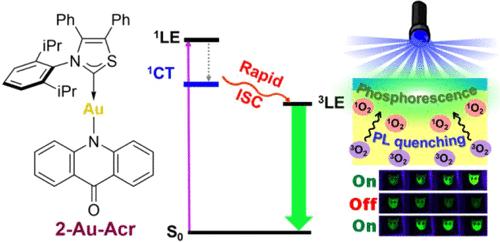Dynamically Switchable Room Temperature Phosphorescence in Two-Coordinate Carbene-Metal-Amide Complexes via Mediation by Charge-Transfer States
IF 7
2区 材料科学
Q2 CHEMISTRY, PHYSICAL
引用次数: 0
Abstract
Due to a weak spin–orbit coupling (SOC) seen in the majority of organic room temperature phosphorescence (RTP) emitters, their light emission profile embodies a substantial contribution from fluorescence, thus obstructing the visual perception of the phosphorescence signal. Here, we present an approach that allows tuning characteristics of organometallic RTP materials from fluorescence-dominated to fully phosphorescent. The investigation of a series of two-coordinate Cu(I), Ag(I), or Au(I)-based complexes bearing an amide-type acridone ligand and several carbene-type ligands with varied electrophilic properties reveals that the intersystem crossing (ISC) rate to the phosphorescent locally excited acridone triplet state (3LE) can be significantly increased if intermediate carbene-to-amide interligand charge-transfer (CT) states are populated during the photoexcitation process. At the same time, the compounds retain long phosphorescence lifetimes in the range of 1.5–73 ms. A purely phosphorescent complex 2-Au-Acr with a high photoluminescence quantum yield of 0.75 was obtained. By exploiting its susceptibility to O2-induced phosphorescence quenching, a dynamically on-and-off switchable phosphorescent polymer-emitter composite system is demonstrated, where the light emission can be controlled solely by the change in the excitation light intensity. The unique properties of the demonstrated complex open unexplored application directions of RTP materials, such as their use in luminescent light intensity sensors.

电荷转移态介导的二坐标碳-金属-酰胺配合物室温磷光动态切换
由于大多数有机室温磷光(RTP)发射体存在弱自旋-轨道耦合(SOC),它们的光发射轮廓体现了荧光的大量贡献,从而阻碍了磷光信号的视觉感知。在这里,我们提出了一种方法,使有机金属RTP材料的特性从荧光主导到完全磷光。对一系列两坐标Cu(I)、Ag(I)或Au(I)基配合物的研究表明,如果在光激发过程中填充中间的碳-酰胺配体间电荷转移(CT)态,则可以显著增加到磷光局部激发吖啶酮三重态(3LE)的系统间交叉(ISC)速率。同时,化合物保持较长的磷光寿命在1.5-73 ms范围内。得到了光致发光量子产率为0.75的纯磷光配合物2-Au-Acr。利用其对o2诱导磷光猝灭的敏感性,展示了一个动态开关磷光聚合物-发射器复合系统,其中光发射可以仅通过激发光强度的变化来控制。所展示的复杂的独特性能打开了RTP材料尚未探索的应用方向,例如它们在发光光强传感器中的应用。
本文章由计算机程序翻译,如有差异,请以英文原文为准。
求助全文
约1分钟内获得全文
求助全文
来源期刊

Chemistry of Materials
工程技术-材料科学:综合
CiteScore
14.10
自引率
5.80%
发文量
929
审稿时长
1.5 months
期刊介绍:
The journal Chemistry of Materials focuses on publishing original research at the intersection of materials science and chemistry. The studies published in the journal involve chemistry as a prominent component and explore topics such as the design, synthesis, characterization, processing, understanding, and application of functional or potentially functional materials. The journal covers various areas of interest, including inorganic and organic solid-state chemistry, nanomaterials, biomaterials, thin films and polymers, and composite/hybrid materials. The journal particularly seeks papers that highlight the creation or development of innovative materials with novel optical, electrical, magnetic, catalytic, or mechanical properties. It is essential that manuscripts on these topics have a primary focus on the chemistry of materials and represent a significant advancement compared to prior research. Before external reviews are sought, submitted manuscripts undergo a review process by a minimum of two editors to ensure their appropriateness for the journal and the presence of sufficient evidence of a significant advance that will be of broad interest to the materials chemistry community.
 求助内容:
求助内容: 应助结果提醒方式:
应助结果提醒方式:


